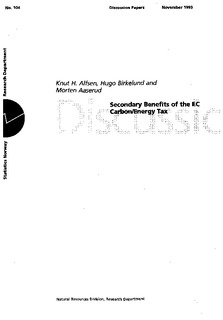| dc.description.abstract | Emissions of CO2, SO2 and NO are all closely linked to burning of fossil fuels. Here we report on simulations done by linking a Sectoral European Energy Model (SEEM) covering energy demand in nine Western European countries with the emission-transportation-deposition model RAINS developed by IIASA. The study analyses emissions of CO2, SO2 and NO., and deposition of sulphur and nitrogen in year 2000 under four different energy scenarios. Two different sets of future behavioural patterns for the thermal electric power production sector is considered. In one regime, called the plan efficient regime, the sector is assumed to follow official plans with regard to investment in new capacity. In the other regime, called the cost efficient regime, the power sector is assumed to behave in a cost minimising manner. The effects of the proposed EC carbon/energy tax are studied under both regimes, giving rise to altogether four scenarios. In both regimes the effect of the EC tax is to reduce emissions by between 6 and 10 per cent in year 2000 relative to the scenarios without the tax. A change of regime, from the regulated plan efficient regime to the market based cost efficient regime, will by itself reduce emissions of CO, and NO), by approximately 3 per cent, while SO 2 emissions are reduced by 13 per cent.
Although the emission reductions may seem modest, they are shown to have a sizeable effect on the technological abatement costs of reaching targets like those prescribed in the Sophia protocol on the stabilisation of NO emissions, and the Helsinki protocol on 502 emission reductions. | nb_NO |
